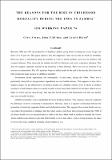| dc.contributor.author | Simms, Chris | |
| dc.contributor.author | Milimo, John T. | |
| dc.contributor.author | Bloom, Gerald | |
| dc.coverage.spatial | Zambia | en_GB |
| dc.date.accessioned | 2014-01-22T15:31:38Z | |
| dc.date.available | 2014-01-22T15:31:38Z | |
| dc.date.issued | 1998 | |
| dc.identifier.citation | Simms, C. et al. (1998) The Reasons for the Rise in Childhood Mortality During the 1980s in Zambia, IDS Working Paper 76, Brighton: IDS. | en_GB |
| dc.identifier.uri | https://opendocs.ids.ac.uk/opendocs/handle/20.500.12413/3394 | |
| dc.description.abstract | Between 1980 and 1991 the proportion of Zambian children dying before reaching five years of age rose
from 15 to 19 percent. This paper explores why this happened. There are no data on trends in morbidity.
However, there is information about the number of visits to health facilities each year by children with
common illnesses. They increased for malaria but fell for diarrhoea and acute respiratory infection. This
does not suggest a dramatic increase in the incidence of these illnesses. There also was no evidence of an
increase in malnutrition. The HIV epidemic began to affect health by the end of the decade, but it does not
fully explain the large increase in childhood mortality.
Government health expenditure fell substantially, in real terms, during the 1980s. There was a
particularly sharp fall in non-personnel expenditure on rural health services. This appears to have had a
negative impact on the effectiveness of primary health care. Zambian mothers were as likely as mothers
elsewhere in Sub-Saharan Africa to consult a health worker when their child fell ill, but their child was less
likely to receive specific drug therapy. One sign that health services had deteriorated was that case fatality
rates rose in health facilities.
Childhood mortality varies considerably between Zambian districts. This variation cannot be explained
by differences in levels of poverty or malnutrition. However, there is a negative relationship between the
proportion of medically supported births and childhood mortality. This suggests that certain health services
can reduce the proportion of children who die. Many deaths could have been prevented during the 1980s if
all district health services had performed as well as the best. More work is needed to identify the factors
which enabled some districts to provide better health services than others. Unless strong measures are taken
to reverse the trend, childhood mortality could continue to rise. | en_GB |
| dc.language.iso | en | en_GB |
| dc.publisher | IDS | en_GB |
| dc.relation.ispartofseries | IDS working papers;76 | |
| dc.rights.uri | http://www.ids.ac.uk/files/dmfile/IDSOpenDocsStandardTermsOfUse.pdf | en_GB |
| dc.subject | Children and Youth | en_GB |
| dc.subject | Health | en_GB |
| dc.title | The Reasons for the Rise in Childhood Mortality During the 1980s in Zambia | en_GB |
| dc.type | IDS Working Paper | en_GB |
| dc.rights.holder | Institute of Development Studies | en_GB |
| dc.identifier.koha | 113258 | |

